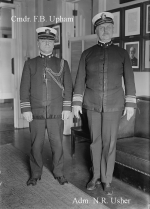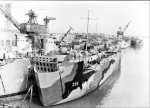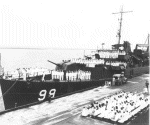Click On Image
For Full Size Image |
Size |
Image Description |
Contributed
By |
 |
78k |
Namesake
Frank Brooks Upham—born on 7 September 1872 at Ft. Apache, Ariz.—was appointed to the Naval Academy on 6 September 1889 and graduated on 2 June 1893. Following the completion of the two required years of postgraduate sea duty—which he served on the Pacific Station in protected cruiser Philadelphia— Upham was commissioned an ensign on 1 July 1895 and joined Olympia (Cruiser No. 6) on 18 July before she sailed for the Far East to become the flagship of the Asiatic Squadron. At the time of the Spanish-American War, Upham was on the staff of the Commander in Chief, Asiatic Squadron, Commodore George Dewey; and the young officer received his baptism of fire during the Battle of Manila Bay. He advanced up the officer ranks of the Navy, eventually attaining flag rank in 1927. During the years before World War I, Upham's sea duty embraced tours in Oregon (Battleship No. 3), New Jersey (Battleship No. 16), and South Dakota (Armored Cruiser No. 9) ; he also commanded Olympia and the yacht Scorpion. He served tours of duty ashore at Newport, R.I., at the Naval War College and in Washington at the Bureau of Ordnance. His overseas shore duty began in the summer of 1911 when he took up the duties of Assistant Naval Attache at Tokyo and Peking, shortly before the outbreak of the Chinese Revolution in October of that year. During World War I, Upham commanded Columbia (Cruiser No. 12) and Pueblo (Armored Cruiser No. 7) and won the Navy Cross for leading the latter during the "difficult, exacting, and hazardous" convoy escort missions across the Atlantic. In the years following the armistice, Capt. Upham was Chief of Staff to the Commander, Battleship Force, Atlantic Fleet—Rear Admiral Hilary P. Jones—before serving successive tours of shore duty: in Paris as naval attache and in Washington assigned to the Office of Naval Intelligence. He commanded Tennessee (BB-43) from September 1924 to March 1926 and subsequently filled the billet of commandant of the naval air station at Pensacola, Fla. He capitalized on this assignment to earn his naval aviation observer's wings. Reaching flag rank in June 1927, Upham successively commanded Battleship Division 3 and Submarine Divisions, Control Force, and served as Chief of the Bureau of Navigation. Given the temporary rank of admiral on 18 August 1933, Upham returned to the Far East as Commander in Chief, Asiatic Fleet, and broke his flag in cruiser Augusta (CA-31) commanded by Capt. (later Fleet Admiral) Chester W. Nimitz. Relieved by Admiral Orin G. Murfin in October 1935, Upham returned to the United States to serve as chairman of the General Board from 20 December 1935 to 30 September 1936. Placed on the retired list on 1 October 1936, Rear Admiral Upham died in San Francisco, Calif., on 15 September 1939.
Digital ID: ggbain 30566 Source: Library of Congress Prints and Photographs Division
Com'r F.B. Upham & Adm. N.R. Usher
Digital ID: ggbain 30567 Source: Library of Congress Prints and Photographs Division |
Bill Gonyo |
 |
133k |
 |
88k |
USS LSM-396, and
USS LSM-308 at the fitting out piers at US Navy Yard, Charleston, S.C. Other ships in this photo include:
USS LSM-309,
USS LSM 389,
USS LSM-390,
USS LSM-391,
USS LSM-392,
USS LSM-393,
USS LSM-394,
USS LSM-395,
USS LSM-397,
USS LSM-398,
USS Ray K. Edwards (APD-96),
USS Arthur L. Bristol (APD-97),
USS Truxtun (APD-98) and
USS Upham (APD-99).
US Navy Yard Charleston photo # 132-46, dated 10 January 1945. |
USS LSM / LSMR Association |
 |
72k |
USS Upham (APD-99) commissioning ceremony, 23 July 1945, at Charleston Navy Yard, Charleston, S.C. |
A. T. Coleman USS Upham |

100413901 |
288k |
U.S. Navy high-speed transports laid up at Green Cove Springs, FL., circa 1947 (l-r):
USS Ruchamkin (APD-89),
USS Bray (APD-139),
USS Rogers Blood (APD-115),
USS Cread (APD-88),
USS Upham (APD-99),
USS Hubbard (APD-53),
USS Walter S. Gorka (APD-114).
RM2/c Ken Adams, U.S. Navy. U.S. Navy photo from the Destroyer Escort Sailors Association |
Robert Hurst |





